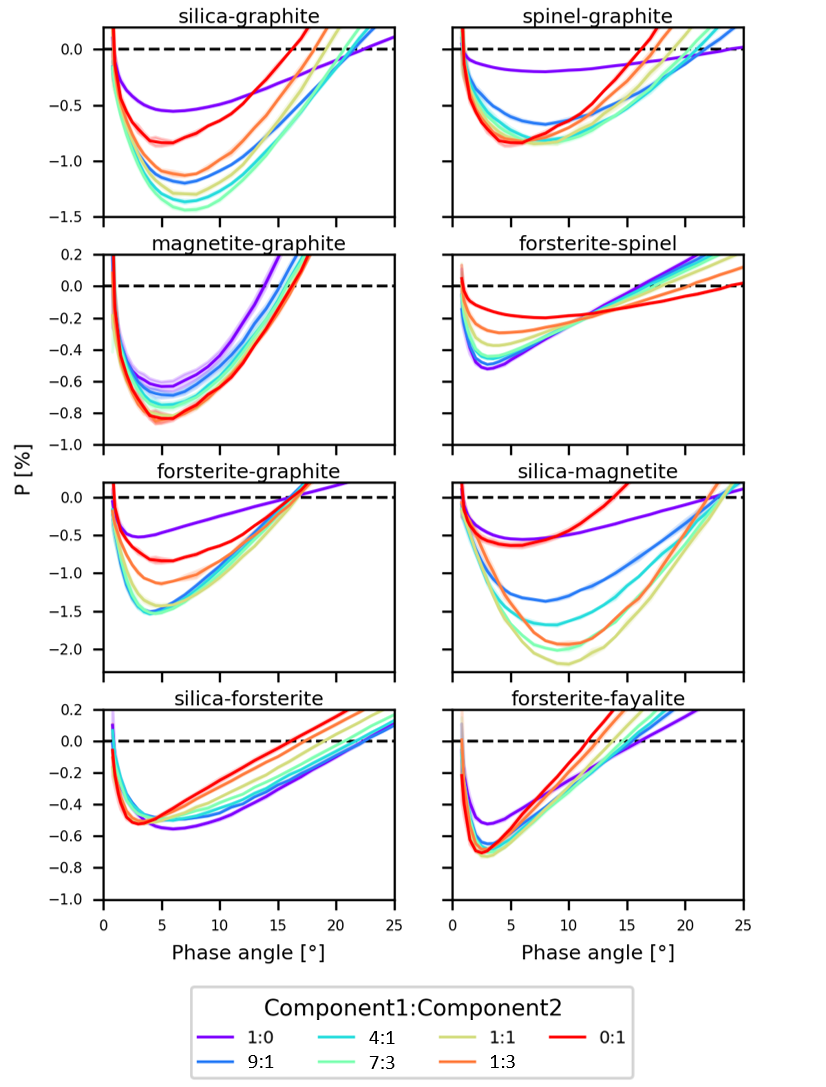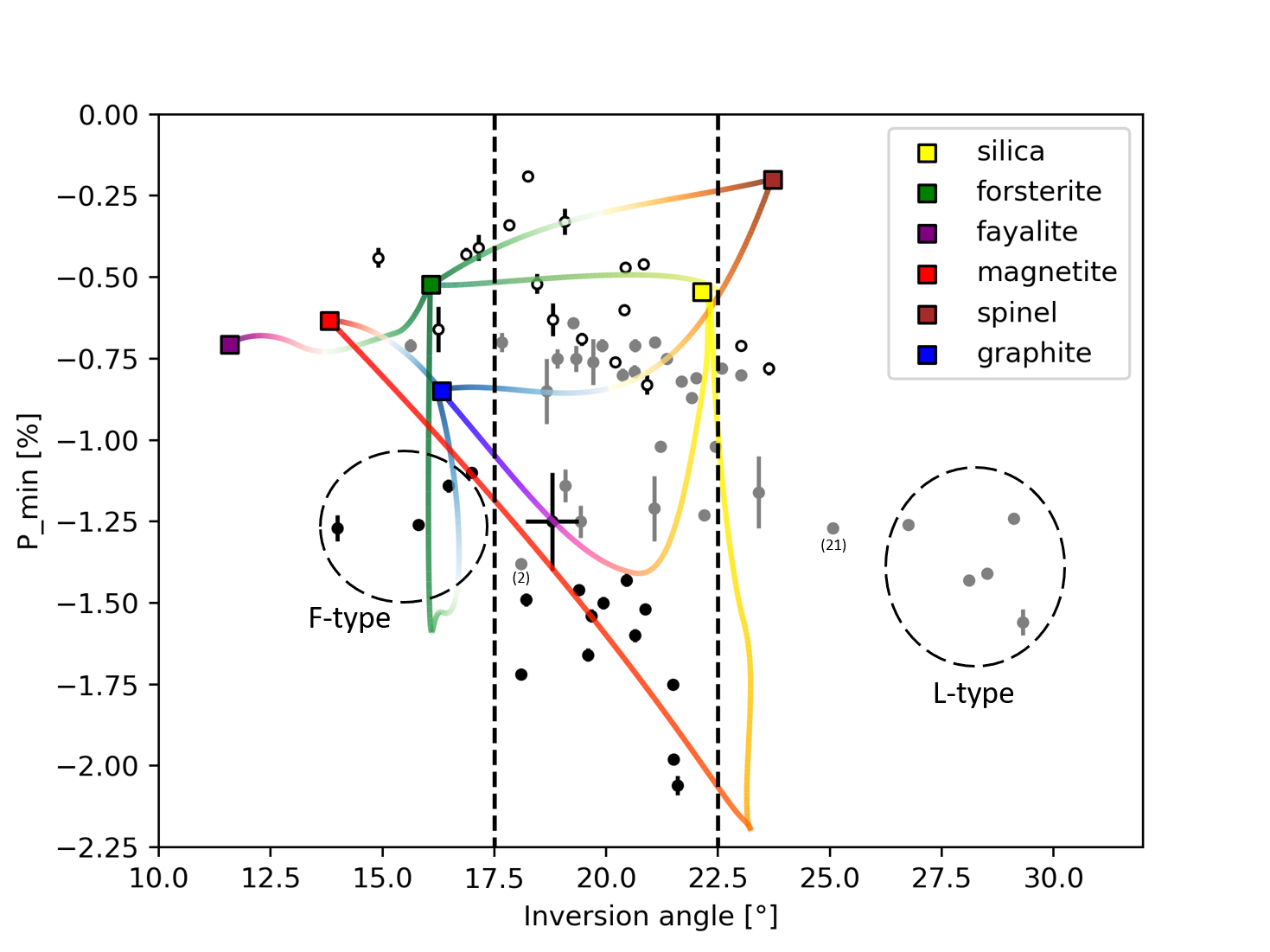Small phase angle polarization properties of regolith-like materials - the "Mixing Effect"
- University of Bern, Physics Institute, Switzerland (stefano.spadaccia@unibe.ch)
Polarization phase curves of asteroids and other small airless bodies are influenced by the compositional and physical properties of their regolith. The mixing of minerals composing the regolith influences the negative polarization at small phase angles as it changes the multiple scattering properties of the medium.
In recent years, two new asteroid classes have been identified by their polarization phase curve at small phase angles [1][2]. The F-class shows an inversion angle (i.e. the phase angle at which the polarization becomes positive) relatively small to other asteroid families (about 14-16°), and the L-class (the so-called “Barbarians” after the prototype of this class (234) Barbara) show very high inversion angles, about 25-30°. The interpretation of these phase curves is challenging, and it has been proposed that the polarization properties of Barbarians are directly correlated to their surface mineralogy, in particular to the presence of spinel-bearing calcium-aluminum inclusions in a dark matrix [3][4]. The F-class peculiar negative polarization has been interpreted as the result of a homogeneous composition of the surface [1].
We know that the surface mineralogy is directly influencing the polarization phase curve of asteroids. In fact, asteroids tend to group in their respective spectral classes when their minimum of polarization is plotted versus [5]. It has been experimentally demonstrated that a mixture of minerals with different albedos can deepen the negative polarization with respect to the polarization phase curves of the single minerals [6][7], and we call this effect the “mixing effect”. A systematic study on the “mixing effect”, however, is lacking in the literature. The mixing of bright ad dark minerals has been studied in polarization only for a few minerals, and it has been used to explain the polarization behavior of F-type asteroids and trans-Neptunian objects [8].
Our work aims to demonstrate experimentally how the “mixing effect” influences the polarization phase curve at small phase angles for different mineralogies relevant for asteroids and to determine how different aggregate sizes affect the negative polarization. We prepared a set of binary and ternary mixtures with different common minerals on asteroids and one set of the same mixture with different aggregate sizes. We measured their reflected light at 530 nm with full-Stokes polarimetry at phase angles ranging from 0.8° to 30°.
The mixing effect of those mixtures with both bright and dark minerals significantly changes the behavior of the phase curves in terms of minimum polarization, phase angle of the minimum, and inversion angle with respect to the mineral components that are mixed together (Fig. 1). Some of the binary mixtures show a deepening of the negative polarization when a low reflectance mineral is mixed with a high reflectance mineral. The inversion angle is affected similarly, increasing respect to the inversion angle of the single minerals. Interestingly, some binary mixtures with high and low reflectance minerals show no deepening of the negative polarization (e.g. spinel and graphite). In general, the polarization phase curve changes significantly every time that two or more minerals are mixed together. Furthermore, we find that the presence of aggregates up to cm-size does not affect the negative polarization.
Our binary mineral mixtures can explore large areas of the space (Fig. 2). Our results show that F-class asteroids could be not as homogeneous as previously thought, since similar reflectance, and can be obtained by a mixture with 1:3 mass ratio of bright and dark minerals (forsterite and graphite).
Barbarians lay in a region that is not explored by our binary mixtures. Nonetheless, we observe that our binary mixtures have a higher inversion angle with increasing contrast of the two end-members (pure Mg-spinel excluded). Other studies found similar results for mixing bright and dark materials: [6] found that the inversion angle increases by 3° compared to pure fine silicates when adding 10% of 10 nm soot, and [7] found that a 1:1 mixture of sub-micron MgO and Fe2O3 shows a 9° higher inversion angle with respect to the highest inversion angle of the end-members (MgO). In our sample, the largest increase in inversion angle is given by a 1:1 mixture of silica and magnetite, with an excess of 1° compared to the inversion angle of pure silica. We expect that mixtures of very fine dark and bright particles could increase even more substantially the inversion angle compared with the single end-members. From this perspective, we propose that the polarimetric behavior of Barbarians is not merely related to the presence of a single mineral, but to a combination of very fine regolith having both bright (CAIs) and dark components that are mixed finely together.
A good synergy between modeling, observations, and laboratory experiments has the potential to strongly aid in interpreting the surface properties of regolith when observing reflected polarized light. Both future sample-return missions and in-situ high sensitive polarimetric observations will greatly improve our
understanding of asteroid regolith properties, helping in the interpretation of astronomical measurements and constraining laboratory simulations to more realistic mineralogies.


[1] Belskaya, I. N., et al. "The F-type asteroids with small inversion angles of polarization." Icarus 178.1 (2005): 213-221
[2] Cellino, A., et al. "The strange polarimetric behavior of Asteroid (234) Barbara." Icarus 180.2 (2006): 565-567.
[3] Sunshine, J. M., et al. "Ancient asteroids enriched in refractory inclusions." Science 320.5875 (2008): 514-517.
[4] Devogèle, Maxime, et al. "New polarimetric and spectroscopic evidence of anomalous enrichment in spinel-bearing calcium-aluminium-rich inclusions among L-type asteroids." Icarus 304 (2018): 31-57.
[5] Belskaya, I. N., et al. "Refining the asteroid taxonomy by polarimetric observations." Icarus 284 (2017): 30-42.
[6] Zellner, B., T. Lebertre, and K. Day. " II-Laboratory polarimetry of dark carbon-bearing silicates." Lunar and Planetary Science Conference Proceedings. Vol. 8. 1977.
[7] Shkuratov, Yu G. "Negative Polarization of Sunlight Scattered from Celestial Bodies-Interpretation of the Wavelength Dependence." Soviet Astronomy Letters 13 (1987): 182.
[8] Bagnulo, Stefano, et al. "Exploring the surface properties of transneptunian objects and Centaurs with polarimetric FORS1/VLT observations." Astronomy & Astrophysics 450.3 (2006): 1239-1248.
How to cite: Spadaccia, S., Patty, L., Capelo, H. L., Thomas, N., and Pommerol, A.: Small phase angle polarization properties of regolith-like materials - the "Mixing Effect", Europlanet Science Congress 2022, Granada, Spain, 18–23 Sep 2022, EPSC2022-516, https://doi.org/10.5194/epsc2022-516, 2022.

